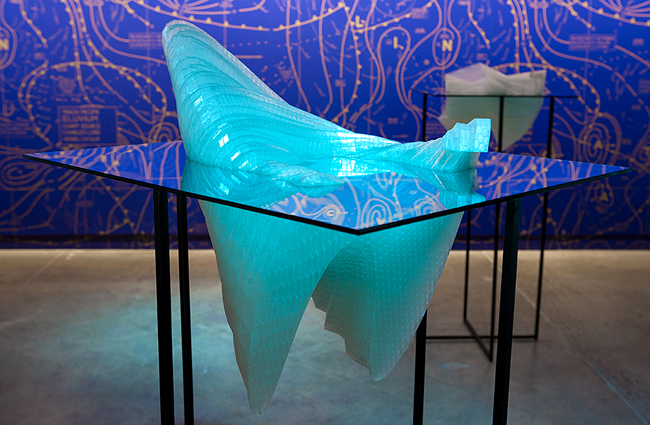While most artists focus on a singling in on one sense of the viewer, Charles Long allows the viewer to feel, touch, smell and hear his exhibit, CATALIN.
“This is immersive and all sensory; it taps into all your senses,” senior curator Heather Pesanti said. “In a way, the sensory overload very much differentiates it. I really love the music and I love spacing out upstairs, listening to the sound track and watching the beautiful videos. For me, to sit on the icebergs and listen to the music upstairs is very meditative.”
All of the senses, except taste, are used on both floors of the exhibit. On each floor, there is a different vinyl record of music playing, giving the environment a serene feel. On the lower level, there are perfumes in iceberg capsules available to smell; these are created by botanical waters from places as far as the glaciers of Alaska to rain in Tasmania. On the second floor, a piece of Catalin, the plastic, from 1927 is on display for viewers to grind down with a file. Along the walls, there’s a “mushroom crypt,” which is a collection of tiles with assorted patterns. Filling the vast area of the room is an ocean of large white spandex figures with different kinds of vents attached to each, known as the “climate controller.”
Catalin was once a sought after plastic known for its translucent nature and vibrant beauty. This material was common in jewelry, radios and toys. In the 1930s, Catalin was discovered to have formaldehyde, a toxic chemical, in it, making this once beautiful material a nightmare.
Inspired by the shift of perspective, Long’s exhibit, CATALIN, is an anagram which stands for “Casually Altering Today’s Atmosphere Living Ironically Now.”
“I don’t like living ironically, but I have a feeling that, in some sense, that’s the best I can do,” Long said.
The exhibit is based on the idea of irony through the different items used to create the exhibit. Most of the material are items used so often that they go unnoticed. These objects are contorted into a refreshingly new and abstract designs.
“It’s something that’s everyday material, like how you get dressed in the morning,” fabrication coordinator Michael Henry said. “Every person has interaction with it, and it’s nice to see it utilized in a different way than what you’re used to seeing it.”
The inspiration for utilizing the daily items was derived from 18 separate collaborators.
“I sometimes forget when I’m talking about the show that it’s actually really the work of many different artists,” Long said. “I’m the ring leader. I designed it and orchestrated it, but there are so many interesting artists that have collaborated to make this wonderful project.”
For each part, an artist with a diverse special worked with Long to capture the various artistic aspects, from models signifying climate control to sculptures that
appreciate beauty.
“The mood of the show is a dark mood because it’s a funeral of our innocence,” Long said. “I’m trying to put out there that it’s okay to feel bad about this. It is bad, but it’s the first step in doing something.”















